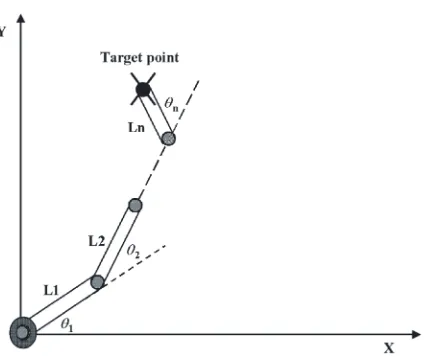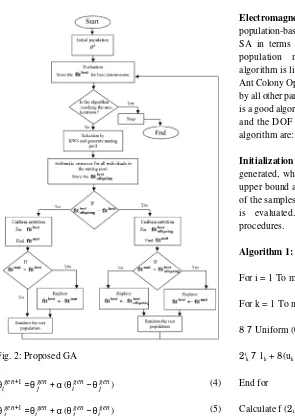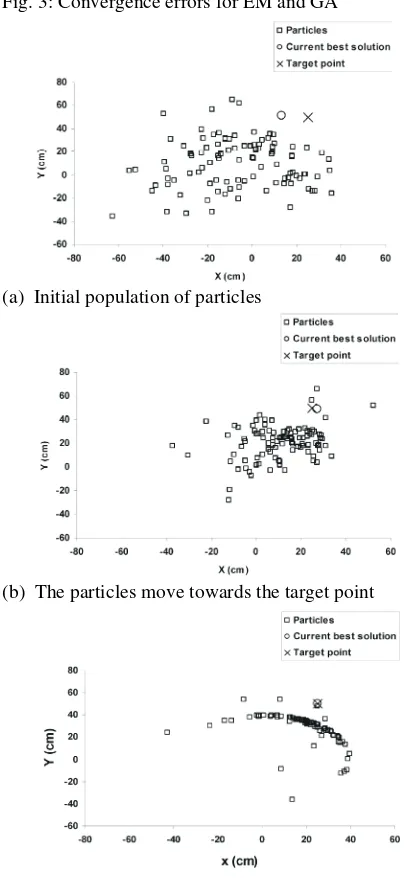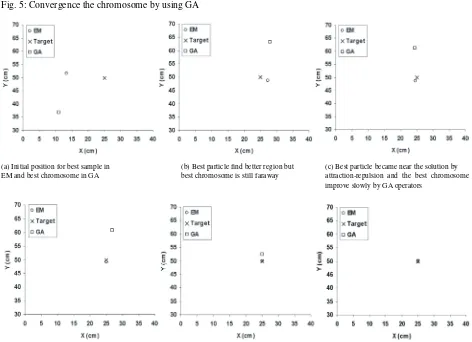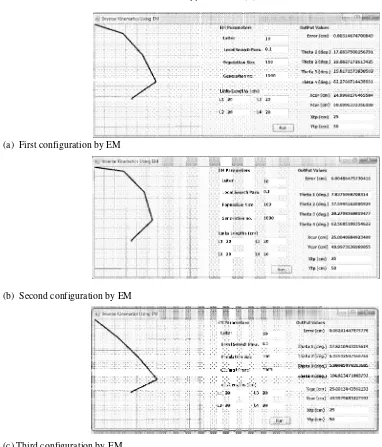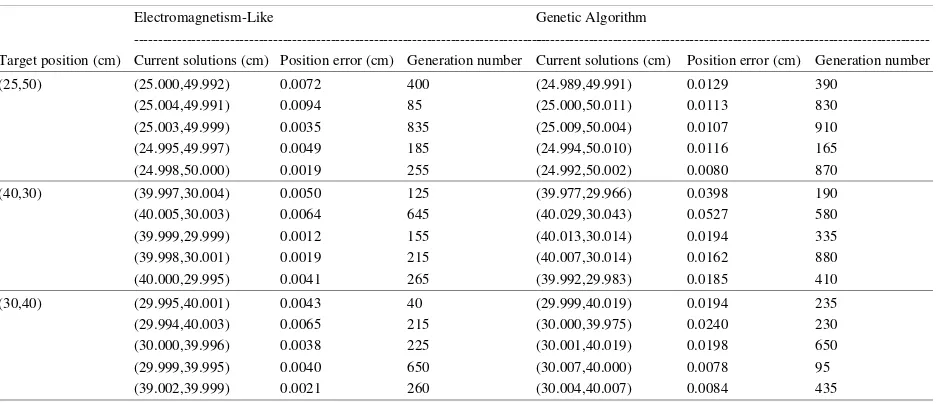ISSN 1818-4952
© IDOSI Publications, 2012
DOI: 10.5829/idosi.wasj.2012.20.07.1771
Corresponding Author: Khairul Salleh Mohamed Sahari, College of Engineering, Universiti Tenaga Nasional (UNITEN), 43000 Kajang, Selangor, Malaysia. Tel: +60-389212020.
Comparison Between Genetic Algorithm and
Electromagnetism-Like Algorithm for Solving Inverse Kinematics
Issa Ahmed Abed, S.P. Koh, Khairul Salleh Mohamed Sahari,
1 1 1
S.K. Tiong and David F.W. Yap
1 2
College of Engineering, Universiti Tenaga Nasional, Selangor, Malaysia
1
Faculty of Electronic and Computer Engineering,
2
Universiti Teknikal Malaysia Melaka, Melaka, Malaysia
Abstract: A comparison study between Electromagnetism-Like Algorithm (EM) and Genetic Algorithm (GA) has been presented in this work to solve the Inverse Kinematics (IK) of a four-link planar robot manipulator. The comparison is focused on some points for both algorithms like the accuracy of the results and the speed of convergence. Different target points have been taken to check the performance of each algorithm to solve the IK problem. The results showed that EM algorithm needs less population size and number of generations to get the true solution. There are multiple robot configurations at the goal points and both algorithms are able to find these solutions at each point. Self developed software simulator is used to display some of these solutions at each goal position.
Key words: Inverse kinematics % Real coded genetic algorithm % Attraction-repulsion mechanism % Planar manipulator
INTRODUCTION kinematics for a three joint robot. The initial and final Nowadays, there are many applications for robots. After that, all the angles that obtained from (x, y, z) These robots have non-linear kinematics equations. coordinates are recorded in a file named as training set of Their inverse kinematics solution provides the joint neural network. Based on metaheuristics algorithms, angles which are required to attain a particular position of Chandra and Rolland [5] proposed hybrid algorithm based the robot wrist in the robot work space [1]. The mapping on genetic algorithm and Simulated Annealing (SA) to from joint space to the end effector space is referred to as solve the forward kinematics of the 3RPR parallel Forward Kinematics (FK). Finding the joint angle of the manipulator. In this method, both algorithms are manipulator from end effector position is referred as hybridized into two hybrid metaheuristic techniques. Inverse Kinematics (IK). The forward kinematics One of the limitations in this method is long optimization equations can be solved easily, but it is difficult to solve time. Two examples for SCARA and PUMA robots have inverse kinematics exactly for high-order degree of been taken by Kalra et al. to check an evolutionary
freedom. approach based on real-coded genetic algorithm to get the
2 2
( tp cur) (tp cur) Error= X −X + Y −Y
{ ,1 2,...., n}
θ′= θ θ′ ′ θ′
Fig. 1: n links planar robot
so on. Feng et al. [8] suggested a method based on electromagnetism-like algorithm and modified Davidon-Fletcher-Powell (DFP) for inverse kinematics. They developed a modified DFP algorithm to fine-tune the approximation results from EM algorithm, at the desired accuracy.
In this paper, a comparison study between EM algorithm and GA has been presented to solve the inverse kinematics for planar robot manipulator. The remainder of the paper is divided as follows. Section 2 is the discussion for problem formulation and the objective function; Section 3 and Section 4 give the explanation for GA and EM algorithm, respectively; Simulation results have been presented in section 5 for both EM algorithm and GA and these results showed the behaviors of each method; finally, the conclusion has been given in Section 6. Problem Formulation: In order to design any job in robotics systems, forward kinematics is required and subsequently, the inverse kinematics. According to the Figure 1, geometric method can be used to find the forward equations for the n DOF planar robot [9] as follows: where Ln denotes the nth link length, 2n is the nth joint angle and (X , Y ) is the current point.cur cur
The error between the current point (X , Y ) and thecur cur target position (X , Y ) of the end effector according totp cur [10] is given as follows:
(3)
Thus, the inverse kinematics problem is to search and find at least one solution that approximates this error to zero. As a result, the problem has been transformed to the minimization of this error.
Real Valued Genetic Algorithm: A genetic algorithm is a global optimization algorithm that depends on the concept of biological structures to natural selection and survival of the fittest [11]. Various operators are used in GA as genetic operators which produce the best individuals from an initial random population. Genetic operators have an important role in the convergence of the genetic algorithm. The basic components of a genetic algorithm are as follows:
Initialization: In the beginning, the individuals are randomly generated, (21,22,...,2m). These individuals or chromosomes represent the problem variables. The solutions are seeded in the area of search space where the optimal solution is possible to be found [5, 12]. Evaluation: In each generation, the parameters of chromosomes are sent to evaluation function to measure the solution value [13].
Selection: The chromosomes will be selected for next generation and this selection will be based on the fitness function of the chromosome.
1 ( ) gene of the new generation and " is a random number
with uniform distribution between zero and one. 2 7 arg min {f(2, i} Mutation: It is the operator which provides the variation where
of individuals during the generations of GA. The mutation
is to avoid the local minimum. Uniform mutation [14] is the m = Is the number of sample points (population size). method that has been used in this paper. In this type of n = Is the dimension for each sample.
mutation, a random number on interval [-s, s] is generated 1 = Lower bound of the k–th dimension. and add to the genes of the chromosome which is u = Upper bound of the k–th dimension.
selected to the mutation operation. f(2) = Is the objective function and it is equal to the Figure 2 shows the steps of our proposed genetic error.
algorithm. In this flow chart, fit is the fitness of the bestbest
chromosome. is the fitness of the best Local Search: Is the procedure that gathers the local chromosome after crossover. fit is the fitness of themut information of each sample point. Algorithm 2 shows the chromosome that produces from mutation. local search procedures [19].
Electromagnetism-like Mechanism: EM is a population-based algorithm. It differs from GA and SA in terms of exchanging the materials between the population members. On the other hand, EM algorithm is like Particle Swarm Optimization (PSO) and Ant Colony Optimization (ACO) in terms of the influence by all other particles in the population [17]. EM algorithm is a good algorithm to solve the IK regardless to geometry and the DOF for robot [8]. The main procedures for the algorithm are:
1
Algorithm 2: search parameter and *, [0, 1] After the initialization of Length 7*(max{u – 1 })k k procedures. First, the maximum feasible step length For i = 1 To m do for each i the initial point 2 is stored in the temporary
For k = 1 To n do random number coordinate by coordinate. Fourth, if the
Conuter 7 1 iterations, then 2 will be replaced by y and the search for
DO and the loop returns again to another iteration for LSITER.
817 U(0, 1)
y 72i force calculation is the calculation of the charge for
827 U(0, 1) sample point are performed for each generation and it
If 81 > 0.5 then objective function for the best point as shown in the
y k 7 y + k 82 *Lenght
Else (6)
y k 7 y – k 82 *Length
End if 2 and f(2 ) is objective function of current best
If f(y) < f(2i) then a sample point. In its place, the difference between the
2i7 y direction of the force between them. Hence,
Counter 7 LSITER -1
End if (7)
Counter 7 counter +1
Loop while counter < LSITER where F is the total force exerted on sample point 2.
End for function attracts the other points. Even so, the point with
End for
2best 7 arg min {f(2i), I} force calculation is to calculate the movement according where, LSITER denotes the local search iterations and in force by random step length. Algorithm 3 shows the this paper, it sets to 10 iterations, * represents the local movement steps.
population, the algorithm starts with local search (Length) is evaluated by using the parameter *. Second,
i
point y. Third, y is moved according to the selected new point in y is a better point than 2i within LSITER
i
this 2i will finish. Or else, the counter is increased by one Finally, 2best is updated.
Total Force Calculations: The first step in the each sample point. The charge calculations for each depends on the objective function of this point and the Eq. (6) [17] :
where f(2i) is the objective function value of sample point i best
solution. Observe that, no sign appeared on the charge of objectives functions of two points will decide the
i i
i
Norm calculation for the force ||F ||i
For k = 1 To n do
Experimental Results: In order to compare the performance of EM algorithm with GA, simulators were conducted using a four-link planar robot manipulator. The simulators were conducted using a self developed GUI to find the inverse kinematics of the manipulator. The links lengths for planar robot are 20 cm each. The upper and lower bound for joint angles are 180° and 0°, respectively. For the comparison between EM algorithm with GA, three target points have been taken to find the inverse kinematics at these points. The population size for both algorithms is 100 and the maximum number of iterations is 1000. All the tests and the results have been done on Celeron ® CPU 2.2 GHz PC. The algorithms are developed and tested using Visual Basic 2008. Figure 3 shows the convergence error for both algorithms. Figures 4 (a)-(c) and Figures 5 (a)-(c) show the movement of the population to the solution for EM algorithm and GA, respectively.
Fig. 3: Convergence errors for EM and GA
(a) Initial population of particles
(b) The particles move towards the target point
(a) Initial population of chromosomes (b)The current solution moves towards the target point (c) The current solution is near the target point
Fig. 5: Convergence the chromosome by using GA
(a) Initial position for best sample in (b) Best particle find better region but (c) Best particle became near the solution by
EM and best chromosome in GA best chromosome is still faraway attraction-repulsion and the best chromosome
improve slowly by GA operators
(d) Best particle is about reaching the solution by (e) Best particle is in the solution and the best (f) Best particle is very close to the target and
attraction-repulsion and the best chromosome chromosome is near the solution best chromosome close to the target
improve by GA operators
Fig. 6: The convergence of the current best solution to the target point
Fig. 6 (a)-(f)show the convergence of the current best Further results are shown in Table 1 for both solution by EM algorithm and GA with respect to the algorithms. According to the result of Table 1, the number target solution. Figures 7 (a)-(c) and Figures 8 (a)-(c) show of iterations for EM algorithm is less than for GA as well the multiple solutions in the same point for EM and GA, as the error produces by GA is bigger than that of EM at
(a) First configuration by EM
(b) Second configuration by EM
(c) Third configuration by EM
Fig. 7: Some configurations for robot manipulator at the target point by EM
(b) Second Configuration by GA
(c) Third Configuration by GA
Fig. 8: Some configurations for robot manipulator at the target point by GA
Table 1 Results for EM and GA
Electromagnetism-Like Genetic Algorithm
---Target position (cm) Current solutions (cm) Position error (cm) Generation number Current solutions (cm) Position error (cm) Generation number
(25,50) (25.000,49.992) 0.0072 400 (24.989,49.991) 0.0129 390
(25.004,49.991) 0.0094 85 (25.000,50.011) 0.0113 830
(25.003,49.999) 0.0035 835 (25.009,50.004) 0.0107 910
(24.995,49.997) 0.0049 185 (24.994,50.010) 0.0116 165
(24.998,50.000) 0.0019 255 (24.992,50.002) 0.0080 870
(40,30) (39.997,30.004) 0.0050 125 (39.977,29.966) 0.0398 190
(40.005,30.003) 0.0064 645 (40.029,30.043) 0.0527 580
(39.999,29.999) 0.0012 155 (40.013,30.014) 0.0194 335
(39.998,30.001) 0.0019 215 (40.007,30.014) 0.0162 880
(40.000,29.995) 0.0041 265 (39.992,29.983) 0.0185 410
(30,40) (29.995,40.001) 0.0043 40 (29.999,40.019) 0.0194 235
(29.994,40.003) 0.0065 215 (30.000,39.975) 0.0240 230
(30.000,39.996) 0.0038 225 (30.001,40.019) 0.0198 650
(29.999,39.995) 0.0040 650 (30.007,40.000) 0.0078 95
(39.002,39.999) 0.0021 260 (30.004,40.007) 0.0084 435
optimum solution. On the other hand, GA uses its 9. Yahya, S., M. Moghavvemi and H.A.F. Mohamed, operators to move the individuals directly to the near 2011. Geometrical approach of planar
hyper-optimal solution. redundant manipulators: Inverse kinematics, path
REFERENCES Practice and Theory, 19: 406-422.
1. Kalra, P., P.B. Mahapatra and D.K. Aggarwal, general end-effector constraints. Robotics and 2006. An evolutionary approach for solving the Autonomous Systems, 55: 316-327.
multimodal inverse kinematics problem of 11. Mitsi, S., K.D. Bouzakis, D. Sagris and G. Mansour, industrial robots. Mechanism and Machine Theory, 2008. Determination of optimum robot base location
41: 1213-1229. considering discrete end-effector positions by means
2. Chapelle, F. and P. Bidaud, 2004. Closed form of hybrid genetic algorithm. Robotics and solutions for inverse kinematics approximation of Computer- Integrated Manufacturing, 24: 50-59. general 6R manipulators. Mechanism and Machine 12. Hnaien, F., X. Delorme and A. Dolgui, 2009. Genetic Theory, 39: 323-338. algorithm for supply planning in two-level assembly 3. Tabandeh, S., C. Clark and W. Melek, 2006. A genetic systems with random lead times. Engineering algorithm approach to solve for multiple solutions of Applications of Artificial Intelligence, 22: 906-915. inverse kinematics using adaptive niching and 13. Lee, M., 2003. Evolution of behaviors in autonomous clustering, IEEE Congress on Evolutionary robot using artificial neural network and genetic Computation, pp: 1815-1822. algorithm. Information Sciences, 155: 43-60. 4. Köker, R., C. öz, T. Çakar and H. Ekiz, 2004. A study 14. Köksoy, O. and T. Yalcinoz, 2008. Robust design
of neural network based inverse kinematics solution using Pareto type optimization: A genetic algorithm for a three-joint robot. Robotics and Autonomous with arithmetic crossover. Computers & Industrial
Systems, 49: 227-234. Engineering, 55: 208-218.
5. Chandra, R. and L. Rolland, 2011. On solving the 15. Li, F., L.D. Xu, C. Jin and H. Wang, 2011. Intelligent forward kinematics of 3RPR planar parallel bionic genetic algorithm (IB-GA) and its manipulator using hybrid metaheuristics. Applied convergence. Expert Systems with Applications, Mathematics and Computation, 217: 8997-9008. 38: 8804-8811.
6. Debels, D., B.D. Reyck, R. Leus and M. Vanhoucke, 16. Maciel, S.L. C.O. Castillo and L.T. Aguilar, 2011. 2006. A hybrid scatter search/electromagnetism Generation of walking periodic motions for a biped meta-heuristic for project scheduling. European robot via genetic algorithms. Applied Soft Journal of Operational Research, 169: 638-653. Computing, 11: 5306-5314.
7. Jamili, A., M.A. Shafia and R.T. Moghaddam, 2011. 17. Yurtkuran, A. and E. Emel, 2010. A new hybrid A hybridization of simulated annealing and electromagnetism-like algorithm for capacited electromagnetism-like mechanism for a periodic job vechicle routing problems. Expert Systems with shop scheduling problem. Expert Systems with Applications, 37: 3427-3433.
Applications, 38: 5895-5901. 18. Chang, P.C., S.H. Chen and C.Y. Fan, 2009. A hybrid 8. Feng, Y., W.Y. Nan and W.S. Ning, 2011. Inverse electromagnetism-like algorithm for single machine kinematic solution for robot manipulator based on scheduling problem. Expert Systems with electromagnetism-like and modified DFP algorithms. Applications, 36: 1259-1267.
Acta Automatica Sinica, 37: 74-82. 19. Birbil, .⁄. and S.C. Fang, 2003. An electromagnetism-planning and workspace. Simulation Modelling 10. Yao, Z. and K. Gupta, 2007. Path planning with
